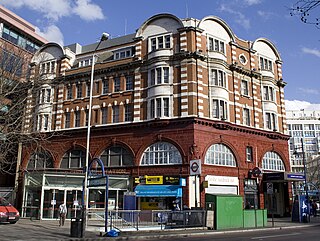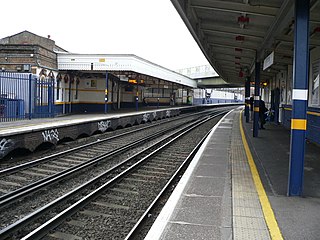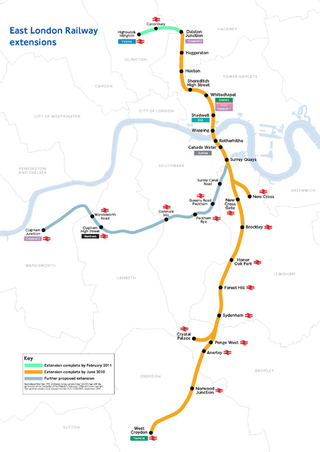
The Bakerloo line is a London Underground line that runs from Harrow & Wealdstone in suburban north-west London to Elephant & Castle in south London, via the West End. Printed in brown on the Tube map, it serves 25 stations, 15 of which are underground, over 23.2 kilometres (14.4 mi). It runs partly on the surface and partly through deep-level tube tunnels.

The North London line (NLL) is a railway line which passes through the inner suburbs of west, north-west, north, and north-east London, England between Richmond in the south-west and Stratford in the east, avoiding central London. Its route is a rough semicircle.

Elephant & Castle is a London Underground station in the London Borough of Southwark in south London. It is on the Bank branch of the Northern line between Kennington and Borough stations, and is the southern terminus of the Bakerloo line, the next station being Lambeth North. The station is in both Travelcard Zones 1 and 2. The Northern line station was opened in 1890 by the City and South London Railway (C&SLR) while the Bakerloo line station was opened sixteen years later by the Baker Street and Waterloo Railway (BS&WR). There is an out-of-station interchange with the nearby Elephant & Castle National Rail station.

Waterloo East railway station, also known as London Waterloo East, is a railway station in central London on the line from Charing Cross through to London Bridge towards Kent, in the south-east of England. It is to the east of London Waterloo railway station and close to Southwark tube station.

Brixton railway station is a commuter railway station in Brixton, South London, UK. It is on the Chatham Main Line, 3 miles 14 chains (5.1 km) down the line from London Victoria. Trains are operated by Southeastern. The typical service is one train every 15 minutes in both directions, from Victoria to Orpington via Bromley South.

Denmark Hill railway station is in the area of Denmark Hill in south London, England, on the South London and Catford Loop lines. It is 4 miles 22 chains (6.9 km) down the line from London Victoria. It is managed by Thameslink. The station is located in London fare zone 2. The station runs services by Thameslink, Southeastern and London Overground.

Wandsworth Road railway station (WWR) is a National Rail station between Battersea and Clapham in south London. It is served by London Overground services between Clapham Junction and Dalston Junction, with a limited service to Battersea Park. It is 1 mile 75 chains (3.1 km) from London Victoria.

Herne Hill railway station is in the London Borough of Lambeth, South London, England, on the boundary between London fare zones 2 and 3. Train services are provided by Thameslink to London Blackfriars, Farringdon, St Pancras International and St Albans on the Thameslink route and by Southeastern to London Victoria and Orpington on the Chatham Main Line. It is 3 miles 76 chains (6.4 km) down the line from Victoria.

Kensington (Olympia) is an interchange station located in Kensington, in West London for London Overground and National Rail services. Limited London Underground services also run here.

Loughborough Junction railway station is a railway station in the Loughborough Junction neighbourhood of the London Borough of Lambeth. It was opened as Loughborough Road by the London, Chatham and Dover Railway in 1864. It is between Elephant & Castle and Herne Hill stations and is served by Thameslink.

Grosvenor Road station was a railway station in London located at the north end of Grosvenor Bridge on the approach tracks to Victoria station. Victoria station was originally operated as two separate parts served by the London, Chatham and Dover Railway (LC&DR) and the London, Brighton and South Coast Railway (LB&SCR) and Grosvenor Road station was also operated in this way. The LC&DR station operated between 1867 and 1911 and the LB&SCR station operated between 1870 and 1907. The station building of the LC&DR station remains on the eastern side of the tracks adjacent to Grosvenor Road (A3212) although no platforms remain at the elevated track level.

London Overground is a suburban rail network serving London and its environs. Established in 2007 to take over Silverlink Metro routes, it now serves a large part of Greater London as well as the home county of Hertfordshire, with 113 stations on the 6 lines that make up the network.

Crossrail 2 is a suspended proposal for a hybrid commuter rail and rapid transit route in South East England, running from nine stations in Surrey to three in Hertfordshire, providing a new North–South rail link across Greater London. It would connect the South West Main Line to the West Anglia Main Line, via Victoria and King's Cross St Pancras. The intent was to alleviate severe overcrowding that would otherwise occur on commuter rail routes into Central London. When first proposed, the hope was for construction to start around 2023, with the new line opening from the early 2030s. The project's cost has been estimated at £31.2 billion.

Elephant & Castle railway station is a National Rail station in Newington, south London. Along with the London Underground station of the same name, it is located in the London Borough of Southwark and is in both Travelcard Zone 1 and 2. The station is managed by Thameslink, with services operated by both Thameslink and Southeastern. There is out-of-station interchange with the nearby Elephant & Castle tube station.

Walworth Road railway station was a railway station in Walworth Road, Southwark, south London, England, on the London Chatham & Dover Railway, which opened on 1 May 1863 on the City Branch to Blackfriars as part of the company's ambitious plan to extend into the City of London. It was originally known as Camberwell Gate before changing its name in 1865.
Borough Road was a mainline railway station in Southwark, south London, located on Borough Road, close to the location Borough Underground station.

The Bakerloo line extension is a proposed extension of the London Underground Bakerloo line in South London from its current terminus at Elephant & Castle to Lewisham station.

Battersea Park Road railway station in Battersea, South London was opened by the London, Chatham and Dover Railway in 1867. It closed in 1916 along with other inner-London stations on the Main Line. Battersea Park railway station, nearby on a different line from London Victoria, remains open. There is no evidence of the station at rail level, but the bricked-up entrance can be seen under the rail bridge close to Battersea Dogs & Cats Home.

The East London line extension (ELLX) project was a British railway engineering project in London, managed by Transport for London. The project involved extending the East London Line and making it part of the mainline London Overground network. This was done by re-opening sections of disused railway line and by converting track electrified by the third-rail system, signalling, lineside signage and communication systems, etc. to mainline standards. New rolling stock was introduced and four new stations built along the route, with a fifth scheduled to be added in the future at New Bermondsey.

The Mid-Kent line is a British railway line running from Courthill Loop North junction to Hayes railway station in the London Borough of Bromley. Despite its name, none of the line is in the present-day county of Kent.




















